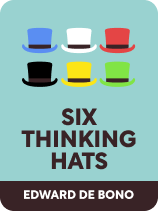

This article is an excerpt from the Shortform book guide to "Six Thinking Hats" by Edward de Bono. Shortform has the world's best summaries and analyses of books you should be reading.
Like this article? Sign up for a free trial here .
What is black hat thinking from Six Thinking Hats? What type of thinking does the black hat represent? When should you wear the black thinking hat?
The black thinking hat is one that many people are adept at using. When you wear the black hat, it’s your job to look for problems and flaws in a situation. However, this hat should not be over-used.
Continue reading to learn when to (and when not to) use black hat thinking.
The Black Hat
The black hat is the critiquing hat. Black hat thinking looks for problems and logical flaws. The black hat is focused on survival—it’s the hat that looks out for danger and keeps us alive. Black hat thinking kept our ancestors from being eaten by predators or falling off cliffs. Being sensitized to danger is a crucial part of our neurochemistry and serves a valuable purpose.
Current education systems, especially at post-secondary level, teach and reward critical thinking, so it’s no surprise that many people are experts with the black hat. They excel in finding problems everywhere and pointing out logical flaws. This is useful and important, because black hat thinking keeps us from making irreparable mistakes. But too much of the black hat can stunt our thinking under other hats, especially yellow and green.
People can misuse the black hat in two ways:
- Those who are black hat thinkers by default often have great difficulty switching off the criticism when it’s time to work with the other hats. This can mean that new ideas get squashed before they have time to grow, or that a proposal is thrown out entirely rather than examined for its potential strengths.
- Black hat thinking can easily become tied to ego. Using the black hat to feel smarter than others is a common abuse of the black hat. It’s important to shelve these motivations as much as possible and remember that black hat thinking serves a larger purpose than ego gratification. Before making a black hat contribution, stop and ask yourself: “Is this genuinely helpful, or am I just saying it to make myself look good?”
Fortunately, people who have learned to overuse the black hat are usually those who benefit the most when they start to consciously practice with it. People who are lifelong black hat thinkers by default often surprise themselves and others with how creative and constructive they can be when they let themselves take off the black hat for a while.
Black Hat Questions
While you’re wearing the black hat, consider these questions:
- What’s wrong with this picture?
- What are the flaws?
- What might go wrong?
- What happens if… (negative event)?
- What happened in the past when people tried to do this?
- What do we risk by taking this course of action?
- What’s the worst possible outcome?
Black Hat Data
Black hat data includes drawbacks, obstacles, design problems, deficiencies, and weak points. It’s important to note that black hat thinking draws significantly on the past: It considers past experiences and uses this to make logical projections into the future. When wearing the black hat, you’re asking, “Has this type of thing failed before? If so, why?”
Most black hat thinking revolves around the word “but”:
- “That marketing plan sounds okay, but I’m not sure it fits the current retail environment.”
- “Earlier bedtimes for the kids are a great idea. But it’ll be tough to get them on board.”
Logical Flaws vs. Practical Obstacles
Black hat thinking is useful for identifying two types of problems:
- Logical flaws in an argument
- Potential design flaws and practical obstacles that a project might face in the real world
Most of us have been taught that if there’s a logical flaw in someone’s argument, their conclusion must be incorrect. However, this isn’t necessarily the case: It’s possible to reach a correct conclusion through faulty reasoning. Because the Six Hats method is concerned with practical usefulness and not logical perfection, finding holes in someone’s argument isn’t enough to invalidate their conclusion. If you find a logical flaw in someone’s argument, go ahead and point it out, but try to trace exactly how it’s leading to an incorrect conclusion.
How to Use the Black Hat
- Be as critical as you like. When it’s designated black hat time, rip as many holes in the idea as you can. By criticizing the project now, you’re providing a valuable service: You’re making sure that something flawed doesn’t go out into the world and do damage or lose the company a lot of money. But:
- Practice switching off the criticism immediately when you take off the black hat.
- Remember that black hat contributions are made alongside other contributions—they don’t override them. If someone finds a serious flaw in a green hat idea or yellow hat proposal that seems to render it unworkable, don’t cross out or delete the first contribution. Simply note down both contributions in parallel.
Advice for Facilitators
- Be vigilant about not letting black hat thinking creep into sections designated for other hats. You may need to call people out directly on this: “Stan, that’s an important thought, but it’s more of a black hat contribution. We’ll get to the black hat in a minute. For now, what neutral information can you give me on this matter?”
- Don’t police people for being “too negative.” Give expert black hat thinkers free rein to do their thing and rip the arguments and proposals on the table to shreds…but only when it’s time for the black hat.
Exercise: Try on the Black Hat
Work with the black hat on a problem of your choice.
- Consider the project or initiative that you’ve been thinking about in previous exercises. What design flaws can you spot? What are the weaknesses in the current approach as it stands right now?
- Think of some similar initiatives that have failed in the past. What went wrong?
- What could go wrong for your project? List all of the possibilities you can think of. Be as harsh and critical as you can.

———End of Preview———
Like what you just read? Read the rest of the world's best book summary and analysis of Edward de Bono's "Six Thinking Hats" at Shortform .
Here's what you'll find in our full Six Thinking Hats summary :
- A handbook for training people to think more efficiently and productively
- An explanation of each of the six thinking hats created by Edward de Bono
- How to calm your inner critic and dramatically cut your decision-making time






